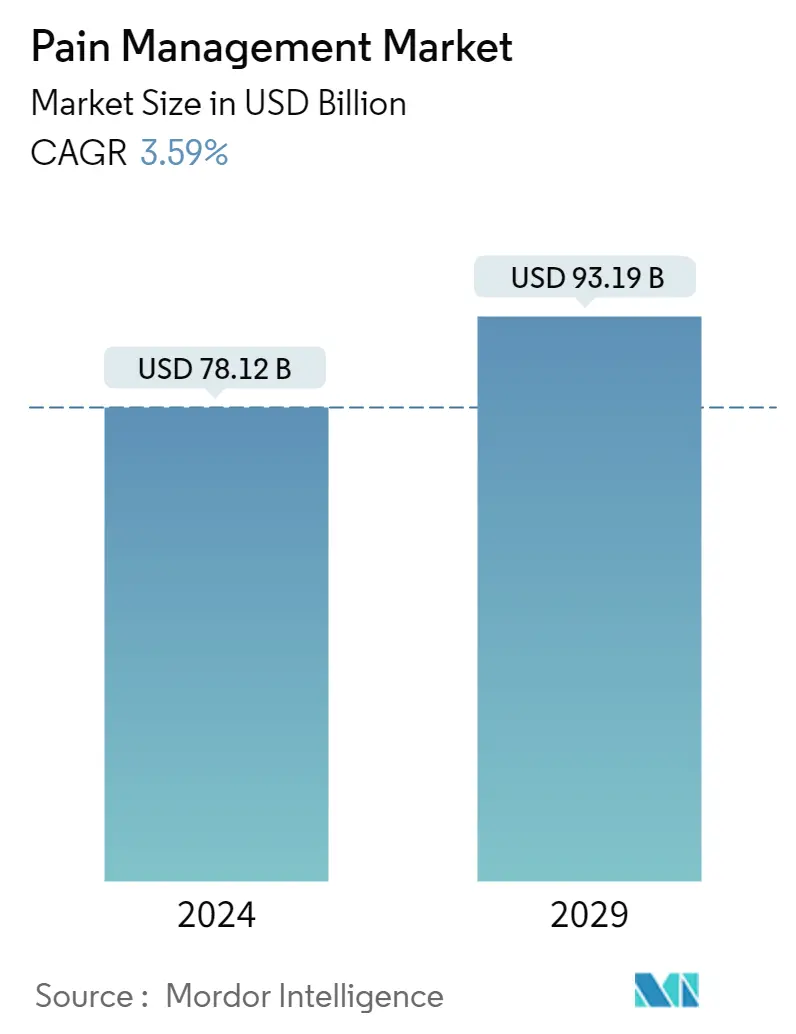Market Size of Pain Management Industry

| Study Period | 2019 - 2029 |
| Market Size (2024) | USD 78.12 Billion |
| Market Size (2029) | USD 93.19 Billion |
| CAGR (2024 - 2029) | 3.59 % |
| Fastest Growing Market | Asia Pacific |
| Largest Market | North America |
Major Players
*Disclaimer: Major Players sorted in no particular order |
Need a report that reflects how COVID-19 has impacted this market and its growth?
Pain Management Market Analysis
The Pain Management Market size is estimated at USD 78.12 billion in 2024, and is expected to reach USD 93.19 billion by 2029, growing at a CAGR of 3.59% during the forecast period (2024-2029).
The COVID-19 pandemic has impacted healthcare systems across the world. Health agencies were involved in containing coronavirus transmission through lockdown norms, and most elective and non-urgent surgeries were postponed globally. As per the Indian Journal of Anaesthesia 2020, COVID-19 negatively impacted pain clinics, including interventional pain management procedures. The Indian Society of Anaesthesiologists also published guidelines on anesthesia and intensive care practices. Also, the Journal of Pain Medicine suggested that epidural nonsteroid injections for radicular pain can be considered in patients who are already immunosuppressed and at high risk of SARS-CoV-2 infection and complications. As per the April 2022 data published by PubMed, it was observed that people across the United States and Canada suffering from chronic pain witnessed a significant increase in pain during the pandemic. However, following the pandemic, effective pain management is practiced among people suffering from chronic pain, as restrictions on non-essential hospital visits are lifted. Hence, it is observed that the current market has reached a pre-pandemic nature.
The well-established business of using painkiller medications as the first line of treatment has significantly contributed to the growth of the pain management market. However, in recent years, the growing reliance on their long-term use, as well as a better understanding of their side effects, has led to an increase in the use of device-based pain management therapies. Post-operative pain is one of the most common. The cost of monitoring and treating adverse effects creates a significant demand for pain management drugs and devices.
The current market is gradually adopting more non-opioid medications to suppress the addiction to opioids and other well-established painkillers on the market. Several non-opioid drugs with mechanisms of action are currently in the early and late stages of development. The regulatory authorities in multiple countries are shifting to alternative approaches, thus fast-tracking those drugs to market approval. The shift is expected to be gradual. Thus, pain management has desirable growth prospects during the forecast period.
The increasing aging population globally is expected to drive the market's growth, as the prevalence of chronic pain is relatively high among the geriatric population and is considered an independent risk factor for mortality. The increasing number of product launches is also expected to drive the market. For instance, in Octover 2021, Esteve Pharmaceuticals received approval from the US FDA for SEGLENTIS (celecoxib and tramadol hydrochloride) for the management of acute pain in adults that is severe enough to require an opioid analgesic and for which alternative treatments are inadequate. Thus, due to such factors, the pain management market is expected to grow significantly over the forecast period.
However, high procedural and purchase costs of pain management devices can restrain the market's growth.

